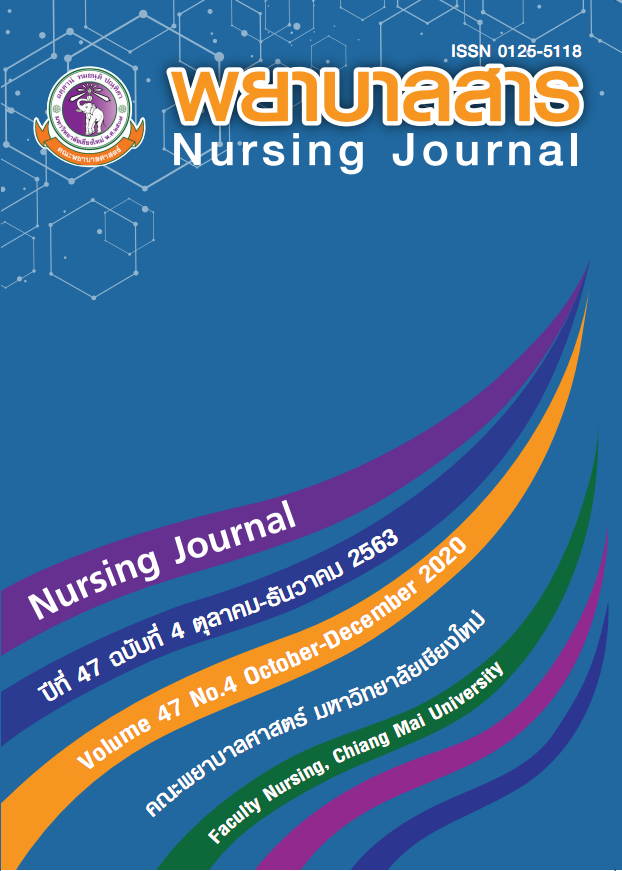Situation Analysis of Occupational and Environmental Health Among Rice Farmers: Health Status and Work Behavior
Keywords:
Health status, Accident and work related injury, Work Behaviors, Rice Farmers, Occupational Health NursesAbstract
Rice farmers are largely part of the informal workforce and face work and non-work related health risks or health problems. The purpose of this descriptive research study was to examine the health status and work behaviors of 385 rice farmers in Wang Thong District, Phitsanulok Province. The study sample was purposively selected based on the inclusion criteria. Data were collected using a structured interview-form developed by the researcher and confirmed for both content validity and reliability. Data were analyzed using descriptive statistics.
The results revealed that:
In terms of general health, 16.4% and 34.3% of the sample had body mass indices in the overweight and obesity ranges, respectively. About 38.7% of the sample had underlying diseases. Over the past month, 75.3% of the sample had moderately good health, while 68.0% and 82.6% had moderately good psychological and physical health. For work-related health risk in the past month, the participants experienced stress/anxiety from situations beyond their control (61.0%), fatigue and thirst (64.2%), and bodily pain (73.5%). Only 8.8% experienced work-related injuries in the past three months. Regarding work behaviors, 61.1%, the lowest proportion across behaviors, regularly practiced personal protective equipment [PPE] use at work (61.1%), while 75.6% of the sample inspected the condition of PPE prior to use, 76.9% cleaned and properly stored PPE after use, and 80.6% replaced PPE when damaged. With regards to adherence to workplace safety rules, 87.0% always cleaned the work area after completing work, 87.7% avoided drinking alcohol before or during work, and 90.6% properly stored tools following use. Avoiding work when fatigued was the rule followed by the smallest proportion of workers (77.9%).
These findings provide a significant foundation for occupational health nurses and related personnel to develop effective health promotion and behavioral modification programs for rice farmers. This is anticipated to prevent and reduce work-related health risks among rice farmers.
References
Bank of Thailand. (2009). Structure of Northern Region economy. Retrieved from http://www.bot.or.th/Thai/EconomicConditions/Thai/North/EcoConditions/EconomicStructure (In Thai)
Bhattarai, D., Singh, S. B., Baral, D., Sah, R. B., Bydhathoki, S. S., & Pokharel, P. K. (2016). Work-related injuries among farmers: A cross-sectional study from rural Nepal. Journal of Occupational Medicine and Toxicology, 11(1): 48-54. doi:10.1186/s2995-016-0137-2.
Bureau of Epidemiology. (2015). Disease report in 506 surveillance system: Leptospirosis. Retrieved from http://www.boe.moph.go.th/boedb/surdata/506wk/y58/d43_1258.pdf (In Thai)
Bureau of Occupational and Environmental Diseases. (2014). Diseases and health hazards among farmers. Retrieved from http://envocc.ddc.moph.go.th/contents/view/403. (In Thai)
Bureau of Occupational and Environmental Diseases. (2010). Manual for public health personnel: Guidelines for implementation of disease-free farmers, safe consumers, herbal detoxification, healthy mind and body. Bangkok: Agriculture Cooperatives of Thailand Press. (In Thai)
Bureau of Occupational and Environmental Diseases. (2018). Situation report: Diseases and health hazards from work and environment in 2017. Nonthaburi: Department of Disease Control, Ministry of Public Health. (In Thai)
Chanprasit, C., & Kaewthummanukul, T. (2010). Occupational health hazards, work-related illness and injury, work behaviors among informal workforce: Case study in baby corn planting farmer group. The Public Health Journal Burapha University, 5(2), 40-50. (In Thai)
Jongrungrotsakul, W., Chanprasit, C, Kaewthummanukul, T., Wisutthananon, A., & Jaiwilai, W. (2019). Occupational Health Risk and Work Related Injuries among Rice Farmers: Case Study in Chiang Mai Province. Nursing Journal, 46(4), 37-48. (In Thai)
Krejcie, R. V., & Morgan, D. W. (1970). Determining sample size for research activities. Educational and Psychological Measurement, 30(3), 607-610.
Kudting, W., & Kanato, M. (2015). Farmers’ knowledge, behavior and health effects from chemical pesticide use in Suksamran Tambon Health Promotion Hospital, Na Dan Subdistrict, Suwannakhuha District, Nong Bua Lam Phu Province. In 34th National Graduate Research Conference (pp. 1281-1292). Khon Kaen: Khon Kaen University. (In Thai)
Kunaviktikul, W. (2019). Occupational health nursing: A challenged role. Nursing Journal, 46(1), 1-3. (In Thai)
National Statistical Office. (2018). Labor force survey in August 2018. Retrieved from http://www.nso.go.th/sites/2014/DocLib13/ด้านสังคม/สาขาแรงงาน/ภาวะการทำงานของประชากร/ภาวะการทำงานของประชากร61. (In Thai)
OSHA. (2016). Recommended practices for safety and health programs. Retrieved from https://www.osha.gov/shpguidelines/docs/OSHA_SHP_Recommended_Practices.pdf
OSHA. (2000). Ergonomics: The study of work, occupational safety and health administration, U.S. Department of Labor. Retrieved from https://www.osha.gov/Publications/osha3125.pdf
Othaganont, P. (2011). The complete life of the Thai elderly, principles of research and lessons learned. Bangkok: Chulalongkorn University Press. (In Thai)
Radzaz, N. H. A., Panatik, S. A., & Nordin, N. A. (2019). Work safety at workplace: Does work experience influence workers safety behavior?. Indian Journal of Public Health Research & Development, 10(6), 1325-1329.
Rogers, B. (2003). Occupational and environmental health nursing: Concepts and practice (2nd ed.). Philadelphia, PA: W.B. Saunders.
Setthetham, D., Nathapindhu, G., Ishida, W., & Patte, T. (2013). Risk behavior and factors affecting to health in rice farmers. KKU Journal for Public Health Research, 6(2), 4-12. (In Thai)
Swangnetr, M., Kaber, D. B., Puntumetakul, R., & Gross, M. T. (2014). Ergonomics-related risk identification and pain analysis for farmers involved in rice field preparation. Work, 49(1), 63-71.
Tammajak, T. (2012). Work related illnesses and injuries among farmers in Huamuang Sub-district, Song District, Phrae Province (Independent study, Chiangmai University). (In Thai)
Yaruang, N., & Sukonthasarn, P. (2016). Occupational safety behaviors and health status among rice farmers in Chiang Rai province. Journal of The Royal Thai Army Nurses, 17(2), 163-174. (In Thai)
Downloads
Published
How to Cite
Issue
Section
License
บทความที่ได้รับการตีพิมพ์เป็นลิขสิทธิ์ของวารสารพยาบาลสาร
ข้อความที่ปรากฏในบทความแต่ละเรื่องในวารสารวิชาการเล่มนี้เป็นความคิดเห็นส่วนตัวของผู้เขียนแต่ละท่านไม่เกี่ยวข้องกับมหาวิทยาลัยเชียงใหม่ และคณาจารย์ท่านอื่นๆในมหาวิทยาลัยฯ แต่อย่างใด ความรับผิดชอบองค์ประกอบทั้งหมดของบทความแต่ละเรื่องเป็นของผู้เขียนแต่ละท่าน หากมีความผิดพลาดใด ๆ ผู้เขียนแต่ละท่านจะรับผิดชอบบทความของตนเองแต่ผู้เดียว






